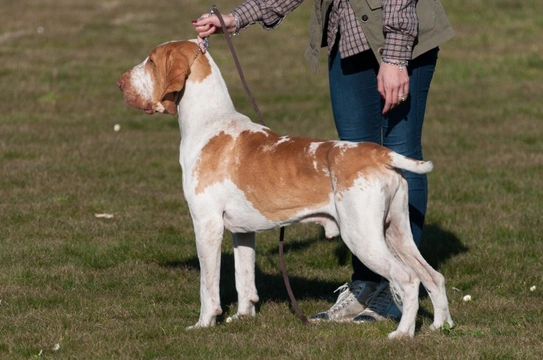
Some frequently asked questions about the Bracco Italiano dog breed
The Bracco Italiano, also sometimes known as the Italian pointer, is a working dog from within the gundog grouping and is a versatile, good all round hunting dog. They do have a very strong prey drive, and require a lot of attention and activity to keep them happy and occupied!
The Bracco is one of the most ancient breeds of dog, with writings and pictorial evidence of dogs of the type going back to the 4th century BC. It is thought that the origins of the breed lie with the coursing Segugio Italiano and the Asiatic mastiff, although some schools of thought state that the Bracco may potentially have ancestry as far back as the ancient St. Hubert hound.
The breed comes in two variants depending upon the geographical origins of the breed line; the Piedmont Bracco Italiano (Piedmontese pointer) and the Lombardy Bracco, or Lombard pointer. While the two variant strains are very similar, the Piedmont variant tends to be lighter coloured and not so heavily built.
As a working dog with a strong hunting drive, the Bracco Italiano can be challenging to keep solely as a domestic pet, but their bright personalities, versatility and other positive traits nevertheless ensure their continued popularity.
In this article, we will cover some of the most frequently asked questions about the Bracco Italiano. Read on to learn more.
What is the Bracco Italiano temperament and core traits?
At home, the Bracco tends to be calm, quiet and laid back, and makes for a good household pet! However, when outdoors and particularly when working, the Bracco is energetic, excitable and very committed to their role. They very much need to receive plenty of mental stimulation as well as physical exercise, and will not be happy if their lives are boring.
They very much like to be involved in family life, and will not be happy if left alone for long periods of time. The Bracco is renowned for suffering from separation anxiety, and so careful training and management when young is required in order to get the dog used to being on their own happily.
They are very open dogs in terms of their temperaments and personalities, and while they can be prone to stubbornness, they are very honest and easy to read compared to most other breeds.
As a hunting dog of the pointer type, they do have an incredibly strong prey drive, which will need to be carefully managed.
What activities are the Bracco Italiano well suited to?
The Bracco is a natural hunting dog, and will not thrive or be happy unless they have a job to do! Families that are involved in gun sport find that the Bracco makes for both an excellent pet and working companion, but for non-hunting families, it is wise to find other ways of keeping your Bracco fit and mentally challenged!
The Bracco usually takes well to canine agility and other canine sports, and it is a good idea to have a plan for activities you can undertake with your Bracco before you take one on.
Are Braccos good with kids?
The Bracco is generally a sociable dog with people, and they are excellent, kind and patient companions for children. They are gentle with small people, not overly boisterous, and have a real soft spot for children!
Do Braccos get on well with other animals?
The Bracco usually gets on well with other dogs, and is comfortable working in a group situation without being overly territorial. However, due to their strong prey drive, they have a tendency to hunt and chase smaller pets such as cats.
Is the Bracco Italiano a good guard dog?
The Bracco Italiano makes for a good watchdog, and they will usually let you know vocally if someone is approaching the home. However, they are not known for their aggression, and do not take well to personal protection or outright guarding roles.
What type of home does the Bracco need?
The ideal home for the Bracco Italiano is one where they can fulfil a working role, or take part in a canine sport that will keep them interested and alert. They need a reasonably large home with an enclosed outdoor area, and need at least two long walks per day to thrive. They will not be happy left home alone for long periods of time, and need as much mental stimulation as they do physical.
Is the Bracco Italiano prone to any health problems?
The Bracco Italiano does not suffer from a huge range of genetically inherited health problems, largely thanks to the efforts of responsible breeders.
One problem that some Braccos may face is entropion or ectropion of the eyelids, which may require surgical correction. CERF testing can be undertaken on breed lines to identify the propensity for this problem. Hip dysplasia also affects some breed lines, and again, hip score testing prior to breeding is recommended.



